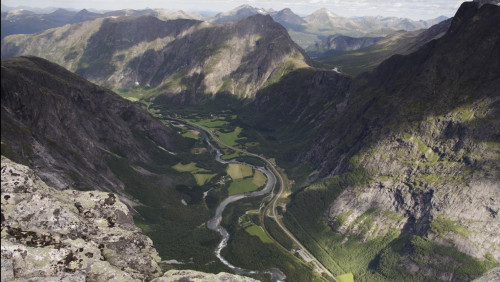English
New Norwegian Record: Hurricane-Force Gusts Over the Fjords Like Never Before

Romsdalen is known for its extreme weather conditions. Fot. Sean Vos (Flickr.com, CC BY-NC 2.0)
The strongest wind ever recorded in Norway was measured at the summit of Mannen in the Romsdalen valley. Gusts reached 62.4 meters per second.
On October 4, the Norwegian Water Resources and Energy Directorate (NVE) recorded gusts of 62.4 m/s, equivalent to 224.6 km/h, during the passage of the extreme weather system Amy. The previous record for 2024, set at Kvaløyfjellet in the Sømna municipality on the Helgeland coast, was 62.3 m/s and has now been surpassed by 0.1 m/s.
The measurement in Romsdalen was taken by a local weather station. The result sets a new national wind speed benchmark in Norway's latest measurement records.
The measurement in Romsdalen was taken by a local weather station. The result sets a new national wind speed benchmark in Norway's latest measurement records.
Norway’s Wind Powerhouse
Møre og Romsdal is famous for its strong winds, as confirmed by the region’s history of extreme weather events. During the hurricane on January 1, 1992, known as the New Year’s storm, winds reached 62 m/s at both Svinøy Cape and Skalmen Lighthouse. Compared to last year’s record, the difference is only 0.1 m/s, indicating increasing variability in weather conditions.
Romsdalen lies in a narrow, deep gorge surrounded by high peaks, which can intensify the force of descending air masses. The area is regularly monitored due to avalanche and landslide risks caused by intense winds.
Romsdalen lies in a narrow, deep gorge surrounded by high peaks, which can intensify the force of descending air masses. The area is regularly monitored due to avalanche and landslide risks caused by intense winds.
Municipalities Demand Greater Protections
This record-breaking measurement presents new challenges for meteorological and emergency services. Strong wind gusts can increase the risk of damage to infrastructure, particularly power lines, roads, and bridges in narrow mountain valleys. Local authorities are calling for more resources and emergency procedures in case of similar extremes.
The risk of damage to forests and disruptions to transport is greatest in the autumn-winter period, when the first snowfalls and icing occur. Monitoring such events is crucial for developing future safety standards and spatial planning, officials report.
The risk of damage to forests and disruptions to transport is greatest in the autumn-winter period, when the first snowfalls and icing occur. Monitoring such events is crucial for developing future safety standards and spatial planning, officials report.
Dodaj komentarz
Wyślij
